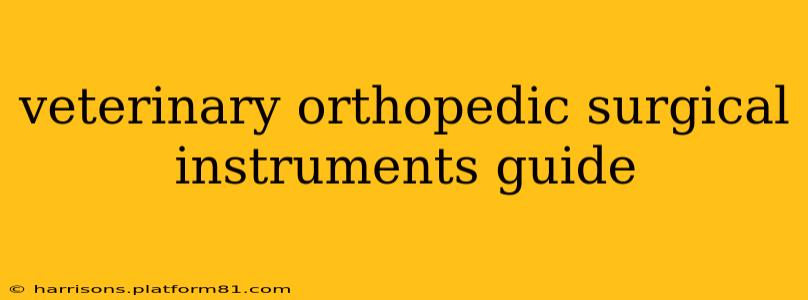Veterinary orthopedic surgery requires a specialized set of instruments to perform complex procedures accurately and safely. This guide provides a comprehensive overview of the essential instruments used in veterinary orthopedic surgery, categorized for clarity and understanding. Understanding these instruments is crucial for veterinary technicians and assistants, as well as students aspiring to a career in veterinary orthopedics.
What are the basic instruments used in veterinary orthopedic surgery?
The basic instruments used in veterinary orthopedic surgery are similar to those used in human orthopedics, but often scaled down to suit the size of the animal patient. They can be broadly categorized into several groups:
1. Cutting Instruments:
- Osteotomes: These chisels are used to cut bone. Different shapes and sizes exist, including straight, angled, and curved osteotomes, allowing for precise bone cuts in various situations.
- Saws: Various saws are used, including reciprocating saws (like a miniature jigsaw), oscillating saws (for finer bone cuts), and hand saws (for specific situations). The choice depends on the bone's density and the surgeon's preference.
- Bone cutters (rongeurs): These are used for removing bone fragments or shaping bone surfaces. They come in various shapes and sizes, with different jaw configurations to address various needs.
- Curettes: Spoon-shaped instruments used to scoop out bone fragments or tissue.
2. Holding and Clamping Instruments:
- Bone holding forceps: These instruments securely hold bone fragments during fracture repair or other procedures. They come in various designs to accommodate different bone shapes and sizes.
- Self-retaining retractors: These keep the surgical site open, providing optimal access for the surgeon. They are particularly important during longer procedures.
- Hemostats: These are used to control bleeding by clamping blood vessels. Different types are available, depending on the size of the vessel.
3. Reduction and Fixation Instruments:
- Reduction forceps: These are used to manipulate and align bone fragments during fracture repair. Specific designs exist for various fracture patterns.
- Drill bits: Various sizes of drill bits are used to create holes in bone for the placement of implants, such as screws or pins.
- Taps: These create threads in bone to secure screws. The tap size must match the screw size.
- Screws and plates: These are commonly used to stabilize fractures. Different sizes and designs exist to accommodate various bone types and fracture patterns.
- Pins and wires: These are used for internal fixation, particularly in smaller animals or specific fracture types.
4. Measuring and Guiding Instruments:
- Calipers: Used to accurately measure bone fragments and guide implant placement.
- Measuring tapes: Used for initial assessment and to measure limb length.
- Templates: Used to assist in the precise placement of implants.
What are some specialized veterinary orthopedic surgical instruments?
Beyond the basic set, several specialized instruments are used for specific procedures:
- Arthroscopy instruments: Used for minimally invasive surgery of joints. These include specialized probes, cameras, and cutting instruments.
- Implants: Veterinary orthopedic surgery utilizes a wide array of implants including screws, plates, pins, intramedullary nails, and external fixators, each designed for specific bone structures and fracture patterns.
- Power instruments: Power drills and saws offer increased speed and precision compared to manual versions.
What are the common materials used in veterinary orthopedic surgical instruments?
Veterinary orthopedic instruments are typically made from stainless steel, known for its durability and resistance to corrosion. Some instruments may incorporate titanium or other materials for specific properties like lightweight strength.
How are veterinary orthopedic surgical instruments sterilized?
Sterilization is critical to prevent infection. Veterinary orthopedic instruments are typically sterilized using autoclaves (steam sterilization) or gas sterilization (ethylene oxide). Strict adherence to sterilization protocols is crucial.
What are some safety precautions when using veterinary orthopedic surgical instruments?
Sharp instruments require careful handling to prevent injury to both the veterinary team and the patient. Proper training and adherence to safety protocols are mandatory.
This guide provides a foundational overview. The specific instruments used will vary based on the specific surgical procedure, the patient's size and breed, and the surgeon's preferences. Always refer to established veterinary surgical techniques and guidelines for detailed procedural information.
